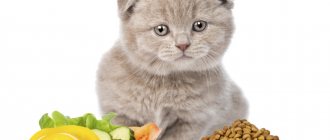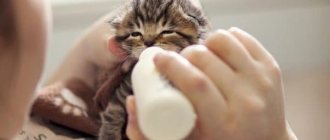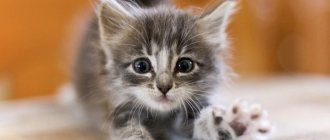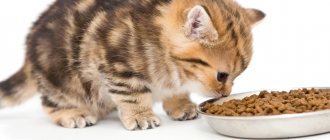Save the article:
When a small kitten appears in the house, which for some reason has lost its mother’s milk, the owners are faced with the question: “What to feed kittens for 1.5 months and how many times a day? In this article we will try to answer questions related to feeding kittens aged 1 to 2 months or more. We will give advice and recommendations on the question: “What to feed a kitten from one month to older age.”
If your kitten is left without mother's milk, then there are two options for getting out of this situation:
- Find a nursing cat that will accept an extra feeder.
- Learn to feed your baby correctly and take responsibility for his life.
Features of development of kittens at 1.5 months
One and a half months is the age in kittens when they begin to look more and more like adult animals. During this period, socialization of small animals occurs. Behavioral attitudes and feeding habits are instilled.
Features of development of kittens at 1.5 months:
- Active growth, development . For these processes to proceed properly, a growing organism needs a lot of energy, which is spent in large quantities. A balanced diet that includes all the necessary nutrients and nutrients will help replenish it.
- Skill development . By 1.5 months, kittens begin to wash themselves and lick their fur. They also become accustomed to the tray, learn to show hunting instincts, control the release of their claws, run, and play with each other.
- Start of feeding . At one and a half months of age, the cubs still feed on their mother's milk, but the body requires a transition to solid food. During this period, the owner must decide what diet to introduce - ready-made food or natural food.
- Understanding the world . Although the kittens are ready to feed on their own, it is not recommended to take them away from their mother at 1.5 months. She still must raise her cubs, instill in them cleanliness, and teach them social skills. The presence of a mother is also important because of unstable thermoregulation, so the cat will warm its offspring.
From 1 to 2 months of life, kittens normally become active, playful, and curious. Their eyes become clearer, open completely, and their body begins to develop harmoniously. The kittens hold their heads steady and walk confidently, although still awkwardly.
Milk replacer
Many kittens at one and a half months still eat their mother's milk, but already need additional feeding: a large litter, poor lactation, the cat is exhausted. But not all kids are ready to eat adult food. For example, large Maine Coons, Persians and Britons take longer to develop. Weak, painful offspring are also formed slowly.
Milk substitutes are produced by many well-known brands:
- Cat-Milk (Gimpet);
- Babycat Milk (Royal Canin);
- Kitty-Milk (Beaphar);
- Kittens Powder (Nurturall-C);
- Katzenmilch (Canina).
Professional substitutes contain additives - taurine, vitamins, minerals, vegetable fats. Taking into account the age and condition of the cat, sometimes they even exceed the composition of mother’s milk. Dilute the powder according to the instructions, give according to the scheme in it. To save nerves and time, it is better to purchase a bottle. It costs a penny, eliminates the need to fiddle with a pipette or syringe without a needle, getting everything dirty. It also has convenient divisions to measure out the required amount of mixture.
Feeding a suckling kitten
For the first 4 days of life, kittens are fed colostrum. This secret is high in calories, high in fats, vitamins, minerals, antibodies, and proteins. It helps strengthen the intestines by populating the walls with beneficial microflora. Then feeding occurs with cat milk.
After reaching the age of one month, milk ceases to be enough for all the needs of the growing body. If there are many cubs in the litter, then this moment comes even earlier. Therefore, it is necessary to gradually introduce complementary foods. By the age of 1.5 months, kittens’ sense of smell begins to work actively, so they sense foreign odors that whet their appetite.
Adding foods or feed rich in proteins, carbohydrates, and vitamins to milk will replenish energy reserves and direct nutrients to meet the needs of a growing body. Microelements will be used to strengthen the musculoskeletal system.
Feeding a suckling kitten does not have a clear plan and start time. If babies are still feeding on mother's milk by 1.5 months, then there is no need to rush into introducing new foods until they begin to show interest in the flavor of food.
Interesting! Sometimes kittens do not react to the food served, then it is necessary to warm them up slightly. They do not accept cold food, since the cat's milk to which they are accustomed is warm.
Allowed natural products for the first feeding:
- whole, homemade goat's milk. Cow's milk is not recommended due to its high milk sugar content;
- broth from lean meat (rabbit, chicken, veal);
- chopped boiled meat (minced meat) with broth or self-prepared pate.
Basic rules of care
Of course, you no longer notice the features of your home, but a new, unknown world, full of fears and smells, opens up for your kitten. Therefore, many kittens experience a real stressful feeling when moving to a new place of residence. And your task is to brighten up the first minutes and days in which the kitten will settle into the house.
There is no need to force your friendship on the kitten or introduce it to other family members. Believe me, when the time comes, the pet will take a step forward. The only thing you need to do is introduce the baby to the bowl, tray and bed.
Feeding a kitten without a mother
Kittens are left without a mother for various reasons. Then feeding and raising the left offspring passes into the hands of the owner. Instead of cat milk, artificial substitutes, infant formula or feed prepared independently are used.
Practical experience suggests that artificial kittens are ready for the first feeding earlier.
This is due to the lack of mother's milk, which makes their digestive tract stronger and less susceptible. Therefore, you can start complementary feeding as early as one month of age.
Feeding a kitten without a mother is a difficult stage in the life of the kids and the owner. After artificial feeding, new foods are introduced slowly, with reaction monitoring. If diarrhea, vomiting, or a sign of allergy are detected, then attempts at administration are postponed for a month.
Natural products
By the age of one and a half months, the kitten’s weight reaches 0.5–0.7 kg. They are ready to feed on their own. When choosing a homemade diet, the owner should know what natural products are allowed for kittens at this age.
List:
- Fermented milk products (cottage cheese, fermented baked milk, yogurt, sour cream, kefir). Kids really like them. Usefulness – high calcium content, necessary to strengthen bones and teeth. Fermented milk products are taken with low or medium fat content.
- Fish. Include it in the diet carefully, as the kitten may not like it at first. For complementary feeding, low-fat varieties are taken (pollock, cod, flounder) without bones or fins. The ideal option is fillet previously scalded with boiling water. It is recommended to give fish no more than once every 7 days.
- Meat. At one and a half months of age it is given only in boiled form. For the first feeding, canned baby meat is suitable. Gradually you can include rabbit, chicken, veal, and turkey. The meat is boiled, finely chopped, preferably on a grater.
- Vegetables. Plant foods must be present in the diet of one and a half month old kittens. For the first feeding, you can take canned baby food. The healthiest green vegetables are broccoli, cucumbers, zucchini, and fresh herbs.
- Cereals. It is given in the form of well-cooked porridges. For nutrition at the age of 1.5 months, buckwheat, rice, pearl barley, and millet are suitable. At first, it is better to buy long-cooking flakes.
The listed products are introduced gradually, starting with easily digestible foods. You can’t give them together; it’s better to include one product every 1-3 days, observing the reaction. If no symptoms of intolerance are detected, then the product remains on a permanent basis.
If the kitten grows and develops quickly, while showing interest in meat products, then you can sometimes give pieces of raw or frozen beef.
Industrial feed
When choosing a ready-made diet, the first complementary foods are based on industrial feeds. Before this, you need to decide whether you are willing to spend money on quality products, since only Premium or Super-premium food is recommended for cats.
Feeding mode
The correct feeding regime allows you to control the functioning of the digestive system and accustom it to the tray. It is established from the beginning of birth to six months.
It is recommended to adhere to the following scheme:
- up to 2 weeks – 10 times;
- by the first month – 8 times;
- up to 2 months – 7 times;
- by the third month – 6 times.
Portions should be small. It is better to give more often so as not to overfeed the animal. At 1.5 months, the number of meals is 6–7 times a day; there is no need to feed at night. If the kittens were fed substitutes, then food is given upon request.
Useful tips
Do not feed your kitten as soon as you wake up. Cats have a good memory. The pet can immediately understand that it will receive food as soon as the owner wakes up, and in the future it will wake him up in the morning.
Decide on a feeding area where the cat will have a bowl of food and water so that it is comfortable and easily accessible for both the pet and the owners.
Do not feed the cat from your table so that it does not get into the habit of disturbing its owners while eating.
Any creature, after it has eaten, needs rest, time to digest the food. This is especially true for kids. You should not immediately start playing with the kitten after eating, hugging it, squeezing it, so as not to harm the baby.
Vitamins and supplements
Kittens' diets should include vitamins and supplements that will help make their diet more balanced and complete. This is especially recommended for artificial kittens and when feeding natural products.
Remember! When feeding with mother's milk or ready-made feeds, the introduction of additives is not required. Their excess is no less dangerous than their deficiency.
Foods rich in nutrients:
- vegetable oils (olive, flaxseed, sunflower);
- dry brewer's yeast;
- vegetables, greens;
- liver;
- meat and bone meal.
A growing baby really needs a rare amino acid - taurine. It is found in turkey, rabbit meat, chicken by-products (hearts, liver), whole milk, and homemade yogurt.
If there is a lack of natural sources of nutrients, you can give pharmaceutical products: fatty acids, B vitamins, fish oil. Complex vitamin and mineral supplements are widely used.
What not to feed a one and a half month old kitten
The owner, when preparing a diet for a little pet, asks a new question: “What can’t you feed a one and a half month old kitten?”
List of prohibited products:
- animal fat, poultry skin, bones;
- dried, dried, smoked, raw fish. Freshwater species are also prohibited;
- sweet fruits (banana, grapes, mango, others);
- sweets, confectionery;
- soybeans, mushrooms;
- expired products;
- dog food;
- food from the master's table;
- stimulants (chocolate, coffee, tea);
- salty dishes with lots of spices and marinade.
Give the following foods with caution: raw pork, sea fish, chicken eggs, cow's milk, store-bought chicken, chicken liver, cereals. When introducing them, you should carefully monitor your pet's reaction.
One and a half months is the age of a kitten when it begins to become an adult. Habits and nutrition change, so the owner must take this into account. At 1.5 months, kittens are introduced to feeding habits depending on the type of diet chosen.











